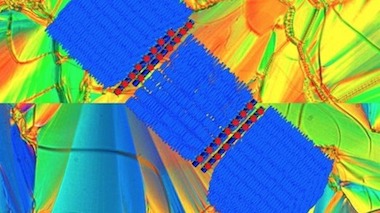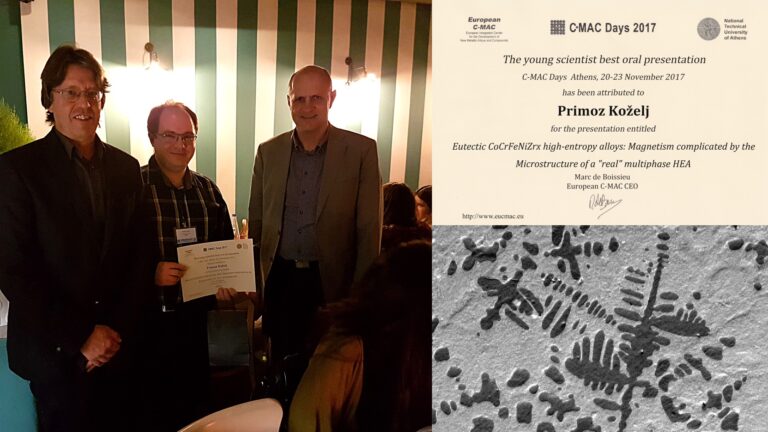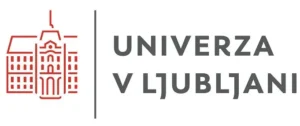News

Image captured by F5 associates on the cover of Liquid Crystals
An image captured by the Calorimetry and dielectric spectroscopy group of the F5 Department was published on the cover of the August issue of the Liquid Crystals Journal. An article of frustrated liquid-crystalline TGB phase stabilisation in the presence of nanoparticles was published in the same issue, based on the study by Maja Trček, George Cordoyiannis, Brigita Rožič, Vassilios Tzitzios, George Nounesis, Samo Kralj, Ioannis Lelidis, Emmanuelle Lacaze, Heinz Amenitsch and Zdravko Kutnjak. The background of the image shows the texture of the TGB order as captured with a camera under a polarised optical microscope. The foreground of the image shows a schematic rendering of the TGB phase structure. The TGB phase is stabilised in a mixture of chiral liquid crystal and nanoparticles. The nanoparticles populated the topological defects of the screw dislocations which are located between the blocks in smectic order.

Dr. Koželj receives Best Oral Presentation Award at C-MAC Dasy 2017
At the international C-MAC Days 2017 conference held at the end of November in Athens, Primož Koželj, PhD, was awarded the Best Oral Presentation Award in the Young Scientists category. In his invited lecture, Dr. Koželj spoke about the magnetism of eutectic high-entropy alloys CoCrFeNiZrx and proved the existence of multi-component magnetic structure inside them, which is the consequence of a complicated microstructure consisting of the eutectic matrix made from two phases and dendrites. The presented research was based on a collaboration between the associates of the Department of Condensed Matter Physics at the JSI (P. Koželj, S. Vrtnik, A. Jelen, J. Luzar, A. Kocjan, J. Dolinšek) and their Slovene colleagues at the Faculty of Chemistry and Chemical Technology of the University of Ljubljana and the Institute of Mathematics, Physics and Mechanics, as well as international collaboration with Swedish (Chalmers University of Technology) and South Korean (Korea Basic Science Institute) scientists.
Original article – 2017
1. Alen Ajanović, Jaka Konda, Gašper Fele-Žorž, Anton Gradišek, Matjaž Gams, Ana Peterlin, Karolina Počivavšek, Mojca Matičič, “Application for sexually transmitted infection risk assessment”, Informatica (Ljublj., Tisk. izd.), 41, 2, 253-254, 2017. [COBISS.SI-ID 30605351]
2. Cristobal Alessandri, Sara Fathipour, Huamin Li, Iljo Kwak, Andrew Kummel, Maja Remškar, Alan Seabaugh, “Reconfigurable electric double layer doping in an nanoribbon transistor”, IEEE trans. electron devices, 64, 12, 5217-5222, 2017. [COBISS.SI-ID 30952231]
3. Fatima Ezahra Annanouch, Sergio Roso, Zouhair Haddi, Stella Vallejos, Polona Umek, Carla Bittencourt, Christopher Blackman, T. Vilic, Eduard Llobet, “p-Type PdO nanoparticles supported on n-type nanoneedles for hydrogen sensing”, Thin solid films, 618, part B, 238-245, 2017. [COBISS.SI-ID 29909799]
4. Bouchra Asbani, Y. Gagou, J. -L. Dellis, Maja Trček, Zdravko Kutnjak, M. Amjoud, A. Lahmar, D. Mezzane, Mimoun El Marssi, “Lead free ferroelectric ceramics exhibiting high electrocaloric properties”, J. appl. phys., 121, 6, 064103, 2017. [COBISS.SI-ID 30250023]
5. Franci Bajd, Martin Škrlep, Marjeta Čandek-Potokar, Igor Serša, “MRI-aided texture analyses of compressed meat products”, J. food eng., 27, 108-118, Aug. 2017. [COBISS.SI-ID 30406439]
6. M. Becerril-Valle, E. Coz, Andre S. H. Prevot, Griša Močnik, Spyros N. Pandis, A. M. Sánchez de la Campa, A.… Read the rest “Original article – 2017”
Published Conference Contribution
1. Alen Ajanović, Karolina Počivavšek, Matic Podpadec, Andrej Ulčar, Ana Marija Peterlin, Ana Prodan, Saša Rink, Anton Gradišek, Matjaž Gams, Gašper Fele-Žorž, Mojca Matičič, “Application for viral hepatitis infection risk assessment”, In: Delavnica za elektronsko in mobilno zdravje ter pametna mesta: zbornik 20. mednarodne multikonference Informacijska družba – IS 2017, 9.-13. oktober 2017, [Ljubljana, Slovenia]: zvezek I: proceedings of the 20th International Multiconference Information Society – IS 2017, 9th-13th October, 2017, Ljubljana, Slovenia: volume I, Matjaž Gams, ed., Aleš Tavčar, ed., Ljubljana, Institut Jožef Stefan, 2017, 46-48. [COBISS.SI-ID 30885415]
2. Jani Bizjak, Anton Gradišek, Luka Stepančič, Hristijan Gjoreski, Matjaž Gams, Karmen Goljuf, “Intelligent system to assist the independent living of the elderly”, In: IE’ 2017, The 13th International Conference on Intelligent Environments, 23-25 August 2017, Seoul, Korea, Jason J. Jung, ed., Danvers, IEEE = Institute of Electrical and Electronics Engineers, 2017, 180-183. [COBISS.SI-ID 30955559]
3. Jani Bizjak, Anton Gradišek, Luka Stepančič, Primož Presetnik, “Bat classification using deep neural network”, In: Slovenska konferenca o umetni inteligenci: zbornik 20. mednarodne multikonference Informacijska družba – IS 2017, 9.-13. oktober 2017, [Ljubljana, Slovenia]: zvezek A: proceedings of the 20th International Multiconference Information Society – IS 2017, 9th-13th October, 2017, Ljubljana, Slovenia: volume A, Mitja Luštrek, ed.,… Read the rest “Published Conference Contribution”
Independent Component Part or a Chapter in a Monograph
1. Igor Muševič, “Solid microparticles in nematic liquid crystals”, In: Liquid crystals with nano and microparticles, (Series in soft condensed matter, 7), Jan P. F. Lagerwall, ed., Giusy Scalia, ed., New Jersey [etc.], World Scientific, cop. 2017, 1, 323-360. [COBISS.SI-ID 30110247]
2. Miha Škarabot, “Manipulation of inclusions with optical tweezers”, In: Liquid crystals with nano and microparticles, (Series in soft condensed matter, 7), Jan P. F. Lagerwall, ed., Giusy Scalia, ed., New Jersey [etc.], World Scientific, cop. 2017, 1, 277-293. [COBISS.SI-ID 30105895]
3. Andrej Zorko, Matej Pregelj, Denis Arčon, “Modern electron paramagnetic resonance techniques and their application to magnetic systems”, In: Handbook of solid state chemistry. Volume 3, Characterization, Richard Dronskowski, ed., Shinichi Kikkawa, ed., Andreas Stein, ed., Weinheim, Wiley-VCH, 2017, 279-309. [COBISS.SI-ID 30785575]
